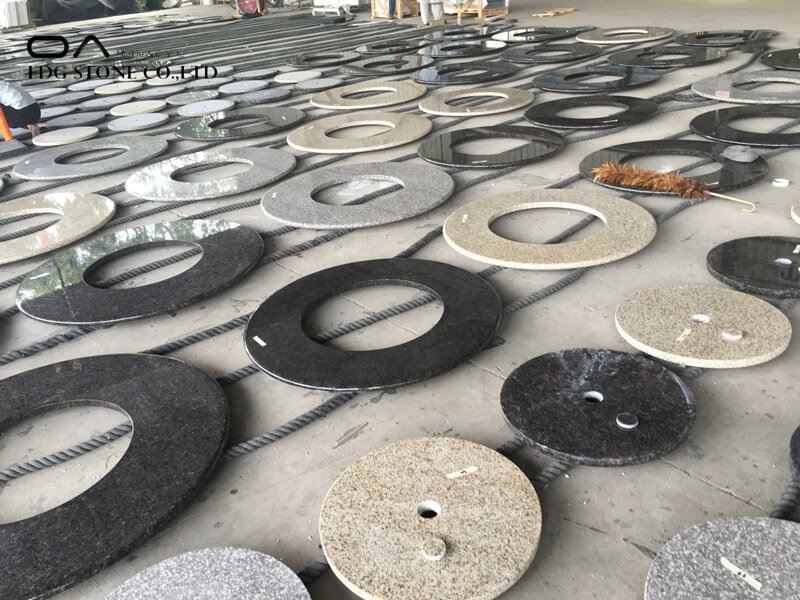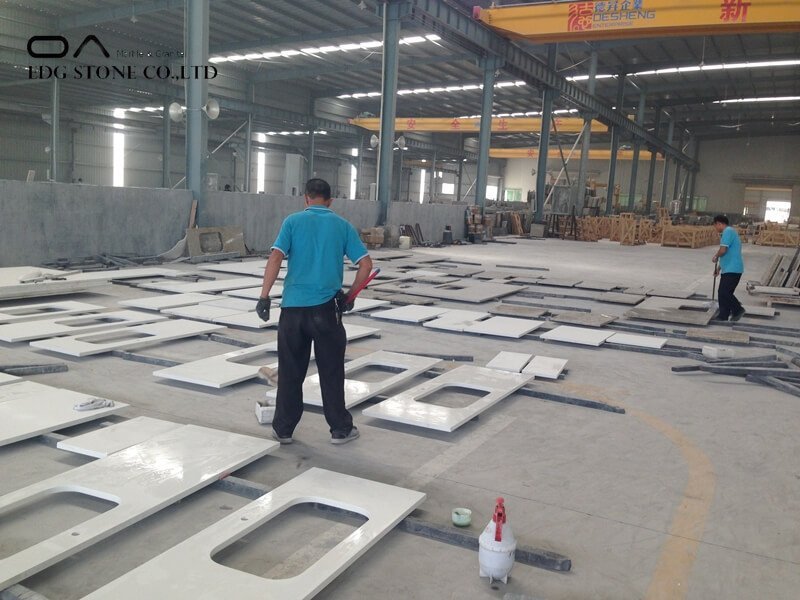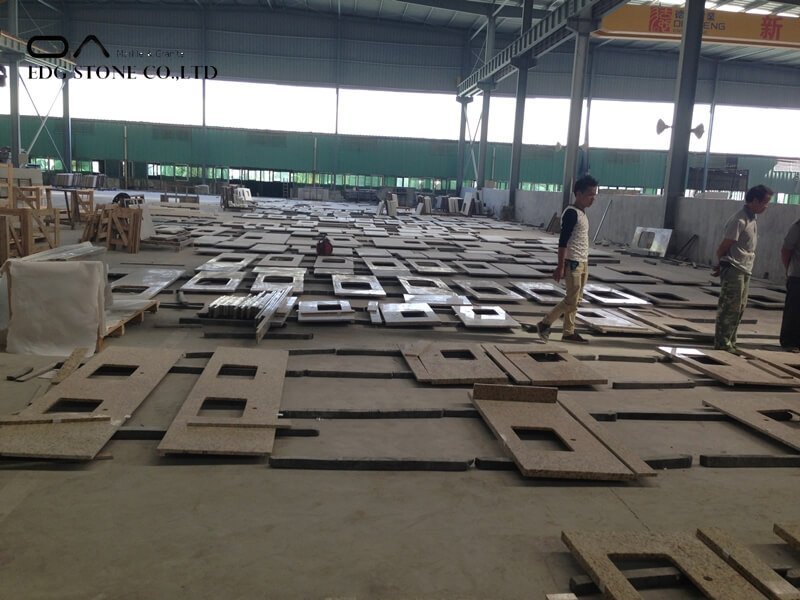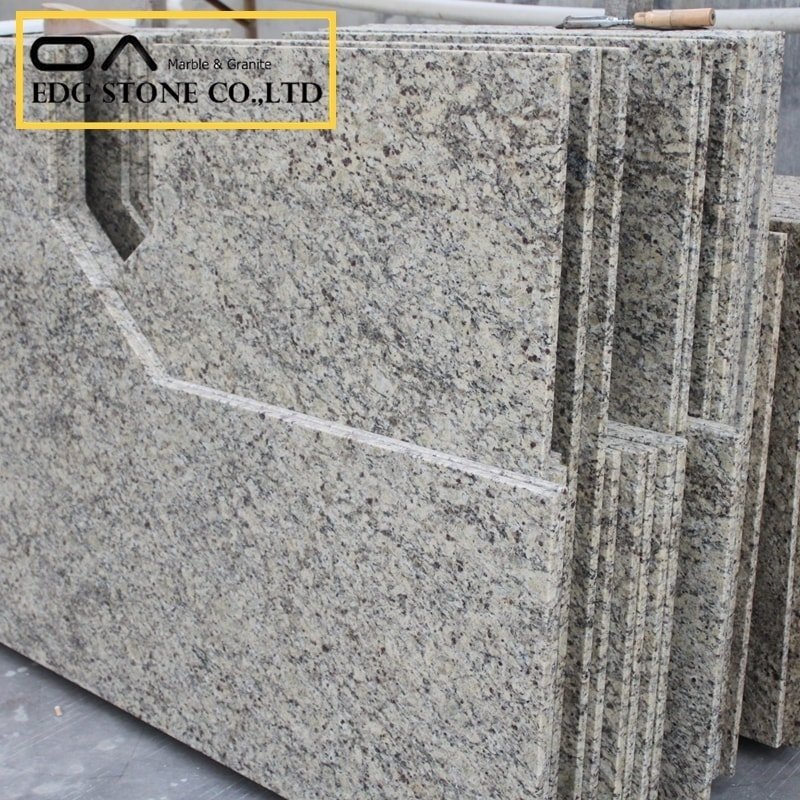Stone countertops mainly include granite countertops, marble countertops, sandstone countertops, slate countertops, limestone countertops, and quartz countertops. The mainstream is granite and marble countertops. In terms of production quantity and application scope, Granite countertops are the most extensive.
The main processing flow of stone countertops is:
Material selection → large cutting → polishing → trimming → edge processing → potting and drilling → polishing and repairing → trial assembly inspection → packaging → completion
Material selection
According to the customer’s sample or production order requirements, select the appropriate rough stone. It is best to knock a block sample for polishing comparison, and observe whether the pattern, color, and particles are consistent. If it is a countertop with a regular thickness, you can also purchase a large board directly from the large board market. The point of attention when selecting materials is to choose blocks or slabs with the same color, the same pattern, the same particle, and close to the density, and no defects such as cracks, stone gall, color lines, flower sweeps, etc. are allowed in the appearance. At the same time, large plates should pay attention to thickness and size issues.
Big cut
It is the process of cutting the blocks into rough boards with a circular saw or sand saw according to the customer’s processing requirements. After cutting, an inspection should be carried out first, the qualified rough boards are kept for use, the unqualified ones are picked out, and the ultra-thick rough boards are subjected to post-processing. (If you are purchasing a large board, you can skip this stage.)
Polished
The polishing stage is divided into two parts: rough grinding and fine grinding.
Rough grinding: The qualified products in the previous process and the rough board with fixed thickness are roughed first with a grinder. At present, the grinder is mainly a hand-held grinder and a multi-head continuous grinding and polishing machine. After the wool board is dry, check the surface of the board. The surface of the board is good and can be finely ground directly. If the quality of the board is found to be unsatisfactory, the surface of the wool board can be brushed and a layer of resin glue will be applied. The small holes, small cracks, chicken feet pattern, and other defects on the wool board can be repaired, and the surface of the wool board can be better and the gloss is higher. In good weather, the resin can generally dry in more than half an hour. If the weather is bad, it will take 1-2 hours to dry. It is best to wait until it dries before performing fine grinding. In some factories, the wool board is washed and inspected without rough grinding, and then glue is directly applied to the wool board (the problematic). Usually, granite is brushed less and marble is brushed more.
Fine grinding: Use a polisher to polish the qualified or repaired mats one by one into matte boards. Remember to use red crayons for the unrepairable cracks, light colors, stone gall, sweeping and other defects in the matte boards. Mark it out on the board so that the next process can be discovered in time, and can avoid these defects to process small-size components, such as water baffles or thickened edges. Generally, the gloss of European and American orders must be above 90° (or processed according to customer requirements, if some stone types cannot meet the requirements, please negotiate with the customer). At the same time, the flatness limit tolerance of the European and American standard matte board is 0.8MM, and the allowable tolerance value of the thickness limit tolerance is plus or minus 1MM.
Trimming
Discharge and cut the qualified matte boards according to the requirements of the production order, and cut out the various parts of the table panel — the main table, the rear baffle, the side baffle, and the front baffle. When cutting, pay attention to the surface before checking, pay attention to the stone defects marked before, avoid cracks, dark spots, color lines, stains, sweeping flowers, etc., and do not have yin and yang surfaces. At the same time, it is necessary to ensure that the geometric dimensions, angle dimensions, and diagonal dimensions of the finished product after cutting are accurate, and no edge chipping or corner drop is allowed. If the back of the countertop needs to be bonded, the edges, edges, and corners of the back must be kept intact to facilitate subsequent edge processing.
Edge processing
Edge processing refers to the processing of the edge of the countertop, whether it is a simple straight edge or a special-shaped edge (bottlenose edge, duck mouth edge, etc.). If the customer does not require the side to be thickened, the table can be directly processed by the side (car side). If the customer requires a thicker side, then the side of the table must be thickened first. The specific method is to use a small cutting machine to smooth the place after adding, and then roughen the bonding surface into a rough surface for more firm bonding, then apply glue to bond, and finally fix it with a clamp. When bonding, pay attention to the gap between the two boards on the bonding surface as small as possible, preferably 0.1 ~ 0.2mm. After the glue dries, the edge can be processed. Advanced factories use special profiling edging machines with manual polishing assistance, while ordinary factories use manual cutting and polishing.
Pot drilling
It is to open the basin mouth, faucet hole, and the installation hole of the under-counter basin on the countertop. The opening is usually made by a machine, and the mouth of the basin is usually opened manually, or the four corners of the washbasin are first opened by an opener and then manually cut.
Buffing and repairing
Repair is to repair damage (slight unevenness or missing corners, etc.) or other natural defects caused by careless processing. Pay attention to repair with glue that is close to the color of the stone. Polishing is to polish the smooth surface of the entire countertop. After polishing, the gloss is required to be more than 90°. At the same time, the surface becomes a mirror gloss, without bumps and waves, and the straightness of the junction is kept in a straight line. The gloss of the edge of the countertop and the top of the washbasin should also be the same as the surface of the sky. It is usually done with a hand grinder. If the effect is good, a large grinder can be used. For countertops that are composed of multiple components, they should be patched and repaired, and polished to avoid problems when they wait for the trial.
Trial test
The panel is inspected block by block, and the unqualified product is found to be replaced or reworked in time. At the same time, for combined countertops that are not a single product, in addition to the smoothness of the edge, the feel and the flatness of the plate, etc., it is also necessary to try to combine them. Pay attention to the unity of the color of the combined countertops, the splicing degree of the interface, and the combination. The left and right sequence must be accurate in accordance with the drawings. If the stitching effect is not good, it must be reworked, and if the color is not uniform, it must be replaced.
Also, if the opening of the washbasin is only 7 or 8cm away from the side, it needs to be reinforced with steel bars. Even if this distance is exceeded, the steel bars must be reinforced on the back if requested by the customer. After the inspection, if the customer requires protection (waterproof treatment, etc.), then protection can be done.
Package
When packaging, the product is packaged according to customer requirements or stone quality. The blunt surface is opposite to the blunt surface, and a scratch-resistant soft film is sandwiched between the smooth surfaces. As for some stone that is afraid of scratches, like general darker stone (such as Shanxi Black), in order to prevent the scratch from affecting the visual inspection, it will be coated. The countertop should be placed vertically so that the stone is stressed vertically and never horizontally. It is best to pack all the countertops into a whole without loosening them.
Finally, you’re done, the countertop is finished, packaged, and ready for shipment.









